


 
 
 
 Photo Essay: Paris, Part VII: Musée RodinFirst posted in February, 2005 Photo Essay: Paris, Part VII: Musée RodinFirst posted in February, 2005
[ Click here to view the previous Paris photography essay. ]
February 9, 2005, 05.15 PM
Varenne, Metro
(Continued)
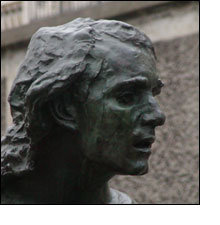 So, as I said, they had to ask me to leave le Musée Rodin. I noticed that a few people had left, then a few more, but I guess I was having such a wonderful time I didn't realize that it was because they were closing (yes, I know). I went to the check room to get my backpack and was a bit embarrassed to see that it was the last thing in their cubicles and that they'd been wondering where the hell I was. Oops. So, as I said, they had to ask me to leave le Musée Rodin. I noticed that a few people had left, then a few more, but I guess I was having such a wonderful time I didn't realize that it was because they were closing (yes, I know). I went to the check room to get my backpack and was a bit embarrassed to see that it was the last thing in their cubicles and that they'd been wondering where the hell I was. Oops.
I did get to see everything before they closed the doors, but had no time whatsoever to sketch. No loss, really, as this notebook really isn't right for it.
I'd seen Rodin's work several times before, even dedicated collections, such as the one in Vancouver, British Columbia, but this exceeded anything I'd seen previously. I don't know what's worse, though, rotating what's on display because you have too many sculptures for the space of your facility, or just shoving them all in there so that everything's on display but a bit cramped. This felt suspiciously like the latter, as quite often sculptures were in too crowded a space, making it diffult to see them from every angle; I was not overly fond of the interior space, and it became even worse when an art class of about thirty students showed up to sketch.
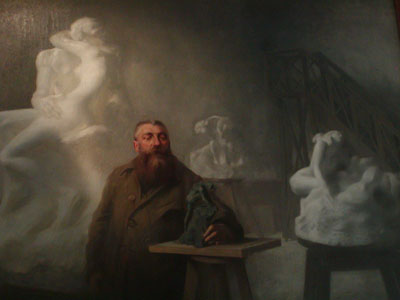
The museum contains not only Rodin, but related works, such as works about Rodin.
Rene Avigdor's painting: Rodin dans son antelier, ca. 1898
In addition to paintings about Rodin, there are a number of sculptures created by his partner, Camille Claudel. They had a rather tragic love affair, one that endured for many years but which ultimately ended and possibly contributed to her eventual paranoia and madness.
When the museum was being planned, sixteen years after their parting, Rodin wrote that "The idea of including some sculptures by Mlle Say would please me very much. This house is quite small and I donít know how the rooms will be arranged. There could be a few buildings for her and for me." (Mademoiselle Say is a play on the French pronunciation of the letter C.)
Evidently, he thought the space rather too small as well.
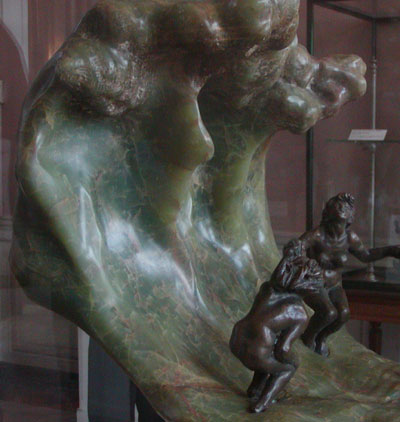
Camille Claudel's Vague, in which figures stand before an oncoming wave,
came years after her seperation from Rodin. Rather than Rodin's influence,
we see Japonese and Art Nouveau reflected in the work.
The saving grace of the museum's tiny, somewhat cluttered rooms, is that it is surrounded by lovely gardens filled with topiary, fountains, open spaces, benches, and, of course, sculptures.
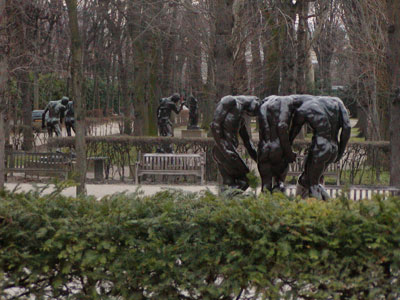
Sculptures throughout the grounds
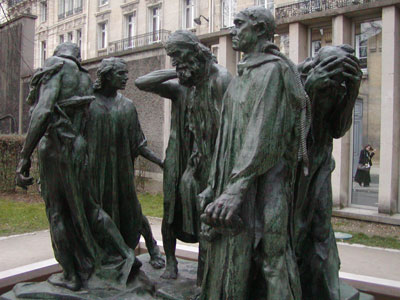
One of my favorites, Les Bourgeois de Calais resides out of doors
I think what I enjoyed most about this museum was that because it was dedicated to Rodin, they had a lot more out on display that you'd normally see (hence the crowding, I suppose), so that you could see studies for pieces and less famous works than those you see in most exhibitions. I saw quite a few works I'd never seen before because of this.
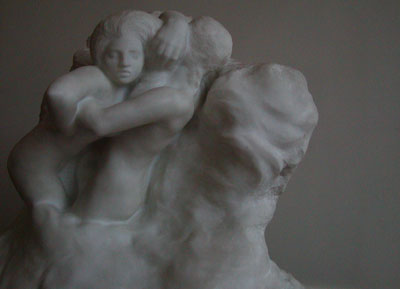
I had never before seen Paolo and Francesca in the Clouds, for instance
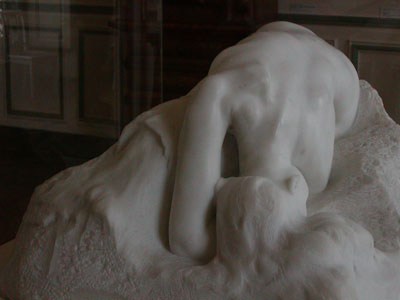
I doubt I've ever seen Danaïde before. If I had, I would certainly
have remembered her. I lost a lot of time gazing at this incredible piece from
every angle. Had I had my sketch book, this would have been my subject for today.
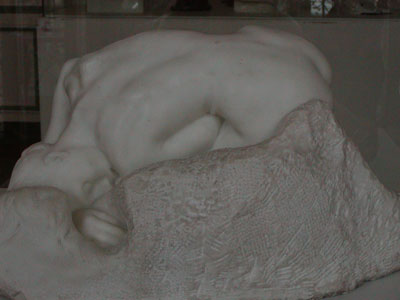
A second point of view.
There were sculptures purposely displayed side by side so as to examine in more detail an aspect of the sculptor's work, and there was also a very impressive exhibit on how bronze sculptures are cast - an education for me and something I'd wondered about from time to time in viewing Rodin's work.
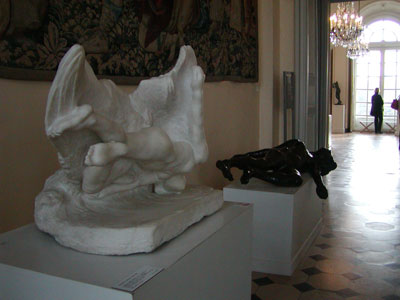
An example of how Rodin used one figure in multiple ways
I opted for the audio tour; well worth it, as I learned a great deal about the artist. I am presently seated at the Varenne stop in the metro. Like the stop near the Louvre, Varenne contains works of art: Le Penseur (The Thinker) and Balzac. The figure of Balzac has jogged my memory on one of the most interesting things I learned during the audio tour.
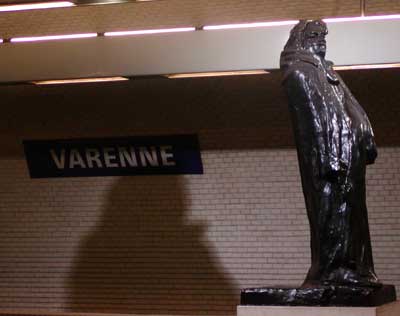
Sculpture of the writer Balzac, Varenne, Metro
I've never been too fond of the sculpture of Balzac, but learned today that Rodin considered it his ultimate life's work, whereas he considered one of his more popular sculptures, Le Baiser (The Kiss), while pleasant enough to look at, to be trendy and formulaic and mindless to sculpt (I'm paraphrasing here, but he was not pleased with that piece).
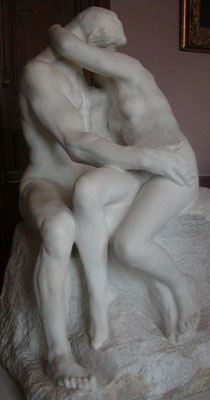
I would have called la Porte de l'Enfer (The Gates of Hell) his crowning achievement. Auguste Rodin's interpretation of Dante's Inferno, la Porte de l'Enfer is definitely his most ambitious work. It is, I think, the most abitious sculpture I have ever seen.
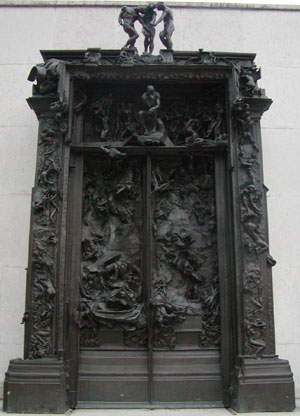
La Porte de l'Enfer is an immense sculpture, comprised of
numerous smaller works. For example, here, Le Penseur is
near the top at center. In addition to The Thinker, you can
some of his other famous works, most notably Les Trois Ombres
(The Three Shades), at top center. These subpieces of the
piece have been cast full size and are probably seen more
frequently as independent pieces than as a portion of
la Porte de l'Enfer.
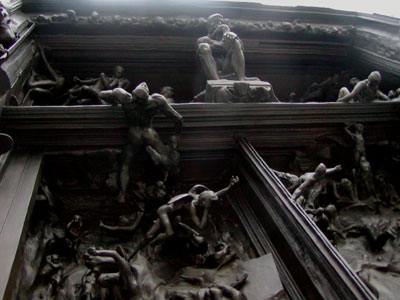
The Thinker sits high overhead, haloed in sunlight from
the garden and surrounded by the souls of Dante's Inferno.
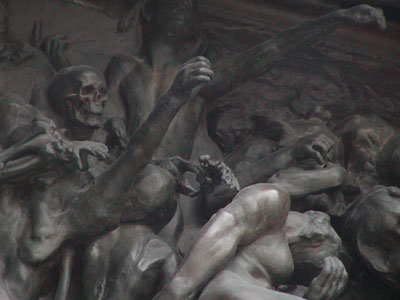
A detail of the death just right of The Thinker.
Perhaps Rodin did not see The Gates of Hell as exceeding Balzac in glory because it was created for the entrance of the Museum of Decorative Arts, a museum that was never actually built, and so the piece itself wasn't cast until nine years after Rodin's death.
Quite sad, really, that he never saw it as we do today.
_____
I think this is the last post about Paris. I could share other entries from my written journal... on the differences between Gare du Nord and the rest of what I've seen of the city, or about the mother and pre-pubescent daughter who were sharing a cigarette at the table next to me in the bar while I was waiting for my train, or the pleasant conversations I had with an old French woman prior to boarding the train, or how riding through the Channel Tunnel is as uneventful as you might imagine it to be, or how absolutely irate my feet are with me after all this sight seeing... but I think I'll let it rest here.
Hope you've enjoyed these photo essays of Paris. Thank you for reading.
[ TOP OF THIS PAGE | MORE PHOTOGRAPHY | MORE WRITING | HOME ]


|





 So, as I said, they had to ask me to leave le Musée Rodin. I noticed that a few people had left, then a few more, but I guess I was having such a wonderful time I didn't realize that it was because they were closing (yes, I know). I went to the check room to get my backpack and was a bit embarrassed to see that it was the last thing in their cubicles and that they'd been wondering where the hell I was. Oops.
So, as I said, they had to ask me to leave le Musée Rodin. I noticed that a few people had left, then a few more, but I guess I was having such a wonderful time I didn't realize that it was because they were closing (yes, I know). I went to the check room to get my backpack and was a bit embarrassed to see that it was the last thing in their cubicles and that they'd been wondering where the hell I was. Oops.












